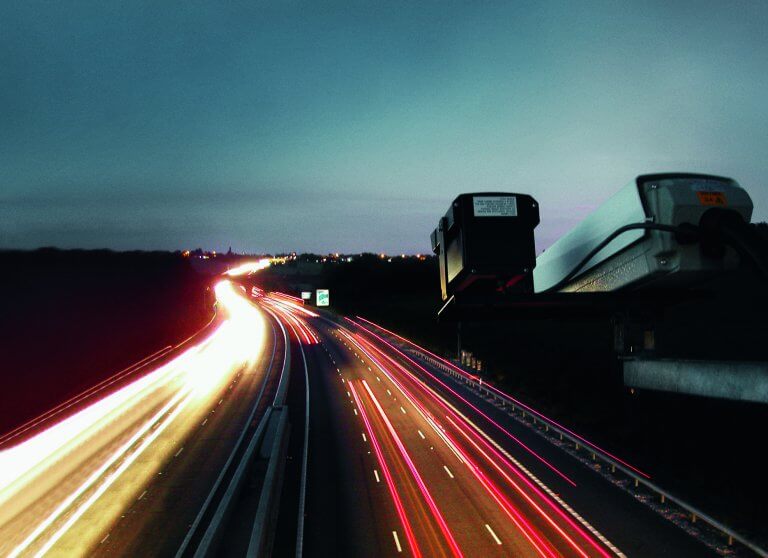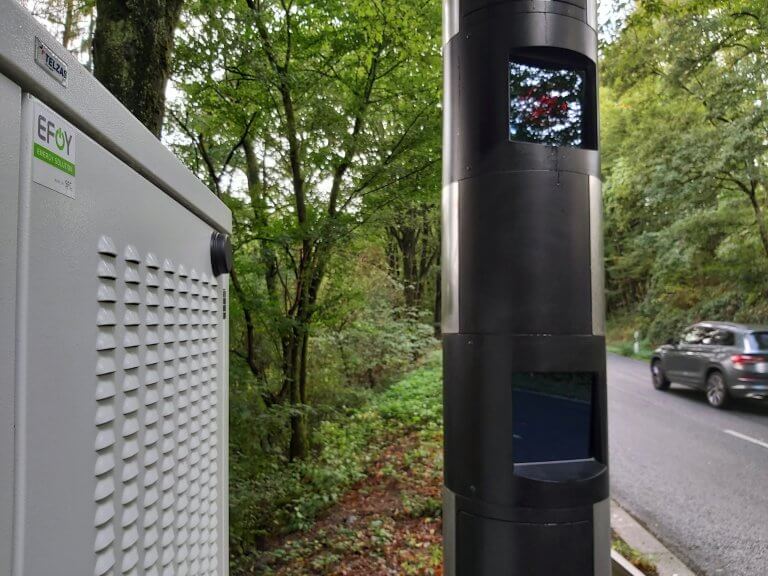Mobile SATCOM Communication Hub
To the reference report







Stationary and mobile radar cameras are used to enforce speed limits and for increased traffic safety, in cities as well as in the countryside.
| Output requirement | Between 50 and 125 W |
| Power requirement | About 1200 to 3000 Wh/day |
In areas with frequent accidents, mains power is often not available. If a camera needs to be set up, reliable, off-grid power will be required. Laying a power cable can cost up to 20,000 Euros per kilometre and it requires a high administrative effort as well as long-term planning.
Reliable, off-grid power with an EFOY/EFOY Pro or a hybrid combination made up of an fuel cell and an existing solar energy system.
The EFOY Pro is compact and flexible in use. It can be integrated into existing control cabinets with little effort or used in an outdoor box – protected from theft and vandalism.
“With the EFOY Pro fuel cell, we have found the right solution!”
The hybrid solution made up of solar module and fuel cell for our remote controlled speed cameras convinced us. After a successful test phase, our nationwide customer installed several roadside speed cameras everywhere in the country. They get their power from the EFOY Pro fuel cell in combination with solar modules. Our customer is thrilled by this solution that uses renewable energies! The speed cameras set up in areas with a lot of accidents represent a win for our customer: Constant availability of the systems, complete remote monitoring and low logistics costs. With the EFOY Pro fuel cell, we have found the right solution!
Roberto Ruiz, Tradesegur, Spain
EFOY energy solutions used worldwide
Have you ever experienced that sinking feeling as you notice the double flash in your rear view mirror? You’ve probably already spotted the bright yellow box with its beady eyes on your vehicle. But did you know there are as many as 14 different types of speed cameras [1], most of which use radar technology? Read on for more information about the most common types of radar cameras used in the UK to help you stay on the right side of the law.
Radar cameras work thanks to the Doppler-Fizeau effect, a physical phenomenon made possible by wave emissions from the radar system. When a wave emitted at a fixed frequency by the radar system encounters a moving vehicle, this wave is then reflected towards the radar cameras.
Gatso radar cameras come from a Dutch company founded in 1959 by Maurice Gatsonides, a famous racing driver. Gatsometer radar cameras [2] are considered the best digital and analogue traffic control equipment worldwide. The Gatso is a rear-facing speed camera that uses radar technology to detect a speeding vehicle. It is rear-facing because of the flash that is triggered. Gatso radar cameras were originally grey but were changed to yellow following a change in the law in 2001.
Their function is to regulate traffic: Either these radar cameras detect the presence of many vehicles and clear the way by activating the green colour of the traffic light. Either it detects that the vehicle’s speed is higher than the authorised limit and activates the colour red, so the driver stops.
Truvelo radar cameras use an infrared flash which allows them to face oncoming traffic as they do not emit a flash [3] which could distract the driver. For this reason, Truvelo radar cameras show the driver of the vehicle as well as the speed of the car, which is necessary information to prosecute speeding offences in some countries. Truvelo speed radar cameras are becoming increasingly popular because, when used, vehicle owners find it difficult to argue that they were not driving at the time of the incident.
Mobile speed radar cameras are used to enforce speed limits across the world and are generally road vehicles fitted with speed camera radar equipment. It is illegal to warn oncoming road users of such a vehicle’s presence by flashing your headlights. [4]
The SpeedSpike system, developed by the American company PIPS Technology, combines a camera conventionally installed on the road with a satellite having a second camera, filming from space. The camera integrated into the satellite calculates the vehicle’s average speed between two defined points at time T. [5]
This technology’s benefit is reducing the average speed of vehicles over more or less long distances and thus no longer be at the sole mercy of motorists slamming on their brakes as they catch sight of the radar. Another advantage is reducing the number of invalid tickets, which are never sent to the perpetrators of a speeding ticket because of a photo that is too vague, sometimes even rendered unreadable and consequently unusable, for example, by the fault of unfavourable weather.
No more worries with SpeedSpike: as soon as the photo is taken by the satellite and the calculation of the average speed is carried out, the registration plate of the vehicle (always clear) can also, if there is any infringement, be sent directly to the competent authorities who then process the report in real-time.
SPECS is a speed enforcement solution that utilises integrated Automatic Number Plate Recognition (ANPR) cameras to track the average traffic speed over a section or network of roads. It has been used to control speeds on notoriously dangerous routes and at significant roadworks since being granted UK Home Office Type Approval (HOTA) in 1999. Temporary and permanent SPECS radar cameras are found mostly across the UK. [6]
As well as limiting speed, new traffic technologies are being introduced on roads to keep traffic moving. Road weather stations send live updates to help the highway authorities decide whether to close roads or send out gritters. Radar cameras detect the presence of rain and snow and calculate its intensity. They also help the Met Office deliver accurate forecasting information for major arterial roads, and over 50 have been installed at critical locations in the last decade. Another nine were installed in 2021, including one at England’s highest altitude motorway sections on the M6 (Shap in Cumbria). [7]
There are many types of radar cameras most of which are aimed at keeping the population safe. These radar based traffic technologies are not only used to monitor traffic offenders, but also to reduce hazards or optimise traffic flow. Please click here for more information about radar cameras or weather stations.
The main types of radar camera system are:
Radar cameras have the following applications:
Radar cameras work thanks to the Doppler-Fizeau effect, which is made possible by the wave emissions of the radar system. When an emitted wave hits a moving vehicle, this wave is reflected towards the radar cameras.
[1] www.theaa.com/driving-advice/legal/speed-cameras
[2] https://www.speedcamerasuk.com/gatso.htm”>Gatsometer radar cameras
[3] https://www.carwow.co.uk/blog/types-of-speed-cameras#gref
[4] https://www.aph.com/community/holidays/mobile-speed-cameras-work-can-expect-warned/
[5] https://www.speedcamerasuk.com/speedspike-speed-camera.htm
[6] https://www.rac.co.uk/drive/advice/cameras/speed-cameras/
[7] https://www.zataiot.com/road-weather-stations-road-weather-information-systemrwis/